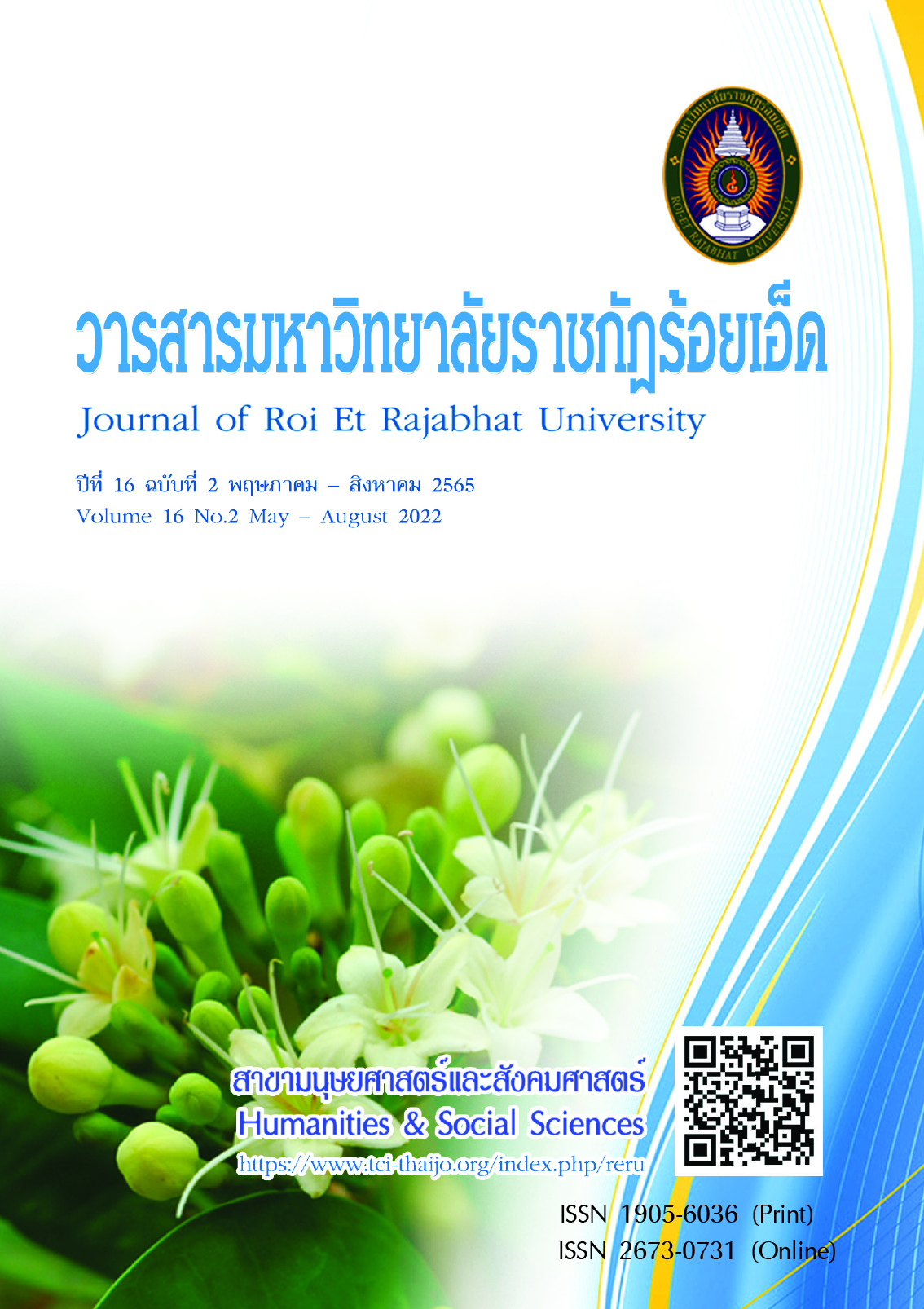การพัฒนาทักษะการแก้ปัญหาทางคณิตศาสตร์และความคิดสร้างสรรค์ของนักเรียน ชั้นประถมศึกษาปีที่ 5 ด้วยการจัดการเรียนรู้รูปแบบ SSCS ร่วมกับเทคนิค STAD
คำสำคัญ:
ทักษะการแก้ปัญหาทางคณิตศาสตร์, ความคิดสร้างสรรค์, การจัดการเรียนรู้รูปแบบ SSCS ร่วมกับเทคนิค STADบทคัดย่อ
การวิจัยครั้งนี้มีวัตถุประสงค์เพื่อ 1) พัฒนาทักษะการแก้ปัญหาของนักเรียนชั้นประถมศึกษาปีที่ 5 ด้วยการจัดการเรียนรู้แบบ SSCS ร่วมกับเทคนิค STAD โดยให้นักเรียนมีคะแนนทักษะการแก้ปัญหา เฉลี่ยไม่น้อยกว่าร้อยละ 70 และมีจำนวนนักเรียนที่ผ่านเกณฑ์ร้อยละ 70 ขึ้นไป และ 2) พัฒนาความคิดสร้างสรรค์ของนักเรียนชั้นประถมศึกษาปีที่ 5 ด้วยการจัดการเรียนรู้แบบ SSCS ร่วมกับเทคนิค STAD โดยให้นักเรียนมีคะแนนความคิดสร้างสรรค์ เฉลี่ยไม่น้อยกว่าร้อยละ 70 และมีจำนวนนักเรียนที่ผ่านเกณฑ์ร้อยละ 70 ขึ้นไป กลุ่มเป้าหมาย คือ นักเรียนชั้นประถมศึกษาปีที่ 5 โรงเรียนบ้านบุ่งวิทยา สังกัดสำนักงานเขตพื้นที่การศึกษาประถมศึกษาอุบลราชธานี เขต 2 ภาคเรียนที่ 1 ปีการศึกษา 2563 จำนวน 23 คน รูปแบบการวิจัยเป็นวิจัยเชิงปฏิบัติการ จำนวน 3 วงจรปฏิบัติการ เครื่องมือที่ใช้ในการวิจัย ประกอบด้วย 1) แผนการจัดการเรียนรู้โดยใช้รูปแบบ SSCS ร่วมกับเทคนิค STAD รายวิชาคณิตศาสตร์ เรื่อง รูปสี่เหลี่ยม ของนักเรียนชั้นประถมศึกษาปีที่ 5 จํานวน 9 แผน เวลา 9 ชั่วโมง 2) แบบบันทึกผลการจัดการเรียนรู้ 3) แบบบันทึกพฤติกรรมการจัดการเรียนรู้ของครู 4) แบบบันทึกพฤติกรรมการเรียนรู้
ของนักเรียน 5) แบบทดสอบทักษะการแก้ปัญหาทางคณิตศาสตร์ 6) แบบทดสอบความคิดสร้างสรรค์ วิเคราะห์ข้อมูลเชิงปริมาณ โดยการหาค่าเฉลี่ย ส่วนเบี่ยงเบนมาตรฐาน และร้อยละ และวิเคราะห์ข้อมูลเชิงคุณภาพ โดยการวิเคราะห์เนื้อหา
ผลการวิจัยพบว่า 1) นักเรียนมีคะแนนทักษะการแก้ปัญหาทางคณิตศาสตร์เฉลี่ยเท่ากับ 45.17 คิดเป็นร้อยละ 75.29 ของคะแนนเต็ม และมีนักเรียนที่ผ่านเกณฑ์จำนวน 18 คน คิดเป็นร้อยละ 78.26 ของจำนวนนักเรียนทั้งหมด ซึ่งสูงกว่าเกณฑ์ที่กำหนดไว้ 2) นักเรียนมีคะแนนความคิดสร้างสรรค์เฉลี่ยเท่ากับ 43.57 คิดเป็นร้อยละ 72.61 ของคะแนนเต็ม
และมีนักเรียนที่ผ่านเกณฑ์จำนวน 17 คน คิดเป็นร้อยละ 73.91 ของจำนวนนักเรียนทั้งหมด ซึ่งสูงกว่าเกณฑ์ที่กำหนดไว้
เอกสารอ้างอิง
กระทรวงศึกษาธิการ. (2551). หลักสูตรแกนกลางการศึกษาขั้นพื้นฐาน พุทธศักราช 2551. กรุงเทพฯ: โรงพิมพ์ชุมนุมสหกรณ์การเกษตรแห่งประเทศไทย จำกัด.
กระทรวงศึกษาธิการ. (2560). ตัวชี้วัดและสาระการเรียนรู้แกนกลาง กลุ่มสาระการเรียนรู้คณิตศาสตร์ (ฉบับปรับปรุง พ.ศ. 2560) ตามหลักสูตรแกนกลางการศึกษาขั้นพื้นฐาน พุทธศักราช 2551. กรุงเทพฯ: โรงพิมพ์ชุมนุมสหกรณ์การเกษตรแห่งประเทศไทย จำกัด.
กาญดาร์ สงควง. (2554). การจัดการเรียนรู้แบบร่วมมือเทคนิคการแข่งขันระหว่างกลุ่มด้วยเกม (TGT) ร่วมกับวิธีสอนการแก้ปัญหาแบบเอสเอสซีเอส (SSCS) ที่มีต่อความสามารถในการแก้โจทย์ปัญหาและความคิดสร้างสรรค์ทางคณิตศาสตร์ของนักเรียนชั้นประถมศึกษาปีที่ 3. วิทยานิพนธ์ การศึกษามหาบัณฑิต สาขาวิชาหลักสูตร และการสอน. ขอนแก่น: มหาวิทยาลัยขอนแก่น.
เจนสมุทร แสงพันธ์. (2548). การใช้คำถามปลายเปิดในการจัดการเรียนการสอนสาระการเรียนรู้ คณิตศาสตร์ ชั้นมัธยมศึกษาปีที่ 4 โรงเรียนสาธิตมหาวิทยาลัยเชียงใหม่. วิทยานิพนธ์ การศึกษามหาบัณฑิต สาขาวิชาคณิตศาสตรศึกษา. เชียงใหม่: มหาวิทยาลัยเชียงใหม่.
ชัยวัฒน์ สุทธิรัตน์. (2550). 80 นวัตกรรมการเรียนรู้ ที่เน้นผู้เรียนเป็นสำคัญ (พิมพ์ครั้งที่ 2). พิษณุโลก: โปรแกรม 82.
นันทพร รอดผล. (2558). การพัฒนาผลการเรียนรู้และความคิดสร้างสรรค์เรื่องสิ่งแวดล้อมและการพัฒนาของนักเรียน ชั้นมัธยมศึกษาปีที่ 4 ด้วยการจัดการเรียนรู้แบบ SSCS. วิทยานิพนธ์ การศึกษามหาบัณฑิต สาขาวิชาการสอนสังคมศึกษา. นครปฐม: มหาวิทยาลัยศิลปากร.
นาถศิริ มุพิลา. (2554). การพัฒนากิจกรรมการเรียนรู้โดยใช้รูปแบบการสอนแบบร่วมมือกันเรียนรู้เทคนิค STAD เรื่องวิธีเรียงสับเปลี่ยนและวิธีจัดหมู่ชั้นมัธยมศึกษาปีที่ 5. วิทยานิพนธ์ ศึกษาศาสตรมหาบัณฑิต สาขาวิชาหลักสูตรและการสอน. ขอนแก่น: มหาวิทยาลัยขอนแก่น.
พัชราวดี ใจแน่น. (2562). การพัฒนาความสามารถในการแก้ปัญหาทางคณิตศาสตร์ของนักเรียนชั้นมัธยมศึกษาปีที่ 5 โดยใช้การจัดการเรียนรู้รูปแบบ SSCS ร่วมกับเทคนิคระดมสะมอง. วิทยานิพนธ์ การศึกษามหาบัณฑิต สาขาวิชาหลักสูตรและการสอน. ขอนแก่น: มหาวิทยาลัยขอนแก่น.
อารี พันธ์มณี. (2540). คิดอย่างสร้างสรรค์ (พิมพ์ครั้งที่ 5). กรุงเทพฯ: ต้นอ้อแกรมมี.
อัญชนา แข่งขัน. (2558). ศึกษาความสามารถในการแก้โจทย์ปัญหาคณิตศาสตร์และการทำงานกลุ่มโดยการจัดการเรียนรู้ แบบ SSCS ร่วมกับเทคนิค STAD. วิทยานิพนธ์ วิทยาศาสตรมหาบัณฑิต สาขาวิชาคณิตศาสตร์ศึกษา. อุบลราชธานี: มหาวิทยาลัยอุบลราชธานี.
Brown, J. D. and Milstead, S. L. (1968). Visualizing data. New Jersey: Hobart Press.
Guilford, J. P. (1956). Structure of intellect psychological. Bulletin, 53(4), 267-293.
Kemmis, S. and McTaggart, R. (1998). The Action Research Planer (3re ed.). Victoria: Deakin University.
Krulik, S. and Rudnick, J. A. (1999). Innovative tasks to improve critical and creativethinking skill. In Stiff, L. V., and Curcio, F. R. Development Mathematics Reasoning in Grade K-12: 1999 Yearbook. Reston, Virginia: National Council of Teachers of Mathematics.
National Council of Teacher of Mathematics [NCTM). (2000). Principles and standards for school mathematics. Reston. Va: NCTM.
Pizzini, L, Shepardson, P. and Abell, K. (1989). A rationale for and the development of a problem solving model instruction in Science Educations. Science Education, 75, 4523-534.
Polya, G. (1957). How to Solve It: A New Aspect of Mathematical Method. New York: Doubleday and Company Garden City.
Polya, G. (1957). How to Solve It: A New Aspect of Mathematical. Method New York: Doubleday and Company Garden City.
Slavin, R. (1995). Cooperative Learning Theory, Research and Practice (2nd ed.). Massachsetts: A Simom & Schuster.
Torrance, E.P. (1965). Rewarding creative behavior. New Jersey: Prentice Hall.
ดาวน์โหลด
เผยแพร่แล้ว
รูปแบบการอ้างอิง
ฉบับ
ประเภทบทความ
สัญญาอนุญาต
ลิขสิทธิ์ (c) 2022 มหาวิทยาลัยราชภัฏร้อยเอ็ด

อนุญาตภายใต้เงื่อนไข Creative Commons Attribution-NonCommercial-NoDerivatives 4.0 International License.
บทความที่ได้รับการตีพิมพ์เป็นลิขสิทธิ์ของวารสารมหาวิทยาลัยราชภัฎร้อยเอ็ด
ข้อความที่ปรากฏในบทความแต่ละเรื่องในวารสารวิชาการเล่มนี้เป็นความคิดเห็นส่วนตัวของผู้เขียนแต่ละท่านไม่เกี่ยวข้องกับมหาวิทยาลัยราชภัฎร้อยเอ็ด และคณาจารย์ท่านอื่นๆในมหาวิทยาลัยฯ แต่อย่างใด ความรับผิดชอบองค์ประกอบทั้งหมดของบทความแต่ละเรื่องเป็นของผู้เขียนแต่ละท่าน หากมีความผิดพลาดใดๆ ผู้เขียนแต่ละท่านจะรับผิดชอบบทความของตนเองแต่ผู้เดียว





